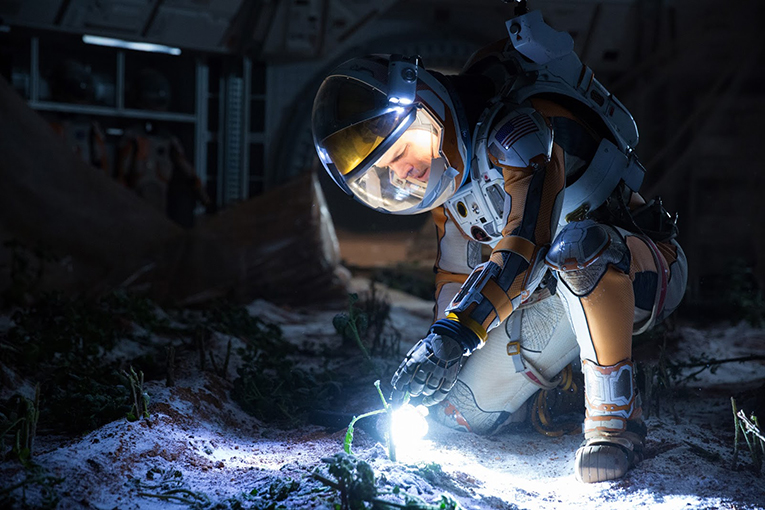
 20th Century Fox 20th Century Fox |
||
| The story about the survival of an astronaut on the red planet that – warning of the authors: hereby spoilers start – ends with a risky and almost impossible rescue. This is, in a nutshell, what happens in The Martian, the North-American science-fiction blockbuster that conquered the screens of the world when it premiered in Autumn 2015. Directed by Ridley Scott and starring Matt Damon as astronaut Mark Watney, the film is based on a 2011 novel by Andy Weir, with the same title, The Martian.
It all starts when, during a manned mission to Mars in 2035 – Ares III – a strong storm surprises Watney and his team. The rest of the crew leaves the astronaut for dead and comes back to Earth. But he has survived and, trapped and alone, with very few supplies, he will have to resort to his wits to manage to notify NASA that is still alive. Despite the nerve-racking situation we have described, the film also has humor to help to humanise the character, who is often optimistic and playful. In fact, the film has won two Golden Globes, precisely to best comedy and best comedy actor. Apart from these awards to its humorous side, the positive reception by public and critics is also reflected on the Oscar nominations, where The Martian can win up to seven golden statuettes. |
«Directed by Ridley Scott and starring Matt Damon as astronaut Mark Watney, the film is based on a 2011 novel by Andy Weir» | |
 20th Century Fox 20th Century Fox |
||
| WEIR’s REALISm
The Martian is a science-fiction movie based on «a novel that tries to be realistic and describes a very plausible mission to the red planet», as Daniel Martín claims in his blog. Martín also explains that the film incorporates current scientific knowledge about Mars. Manuel Moreno, PhD in Physics of the Universitat Politècnica de Catalunya, and Juan Fabregat, Full Professor of Astronomy and Astrophysics of the University of Valencia, analyse the scientific and technological references of the film, what is fantasy and what reality in what we see in this cinema cocktail. «According to his biography, Andy Weir [the author of the book] is a computer engineer interested in relativistic physics and orbital mechanics», the physicist Manuel Moreno says. «Therefore, all the technoscientific aspects of the story are, generally, well treated, although concessions are made in order to advance the plot», adds Moreno, who has focused his research activity on astronomy, specifically on stellar kinematics and the global structure of the galaxy. He is also the author of De King Kong a Einstein (“From King Kong to Einstein, Editorial UPC. Barcelona, 2009), in which he examines physics as shown by science-fiction movies. In university lessons, Moreno often uses this literary and film genre as a teaching tool. His methodology consists on recommending readings and show scenes from interesting films to analyse them from a scientific standpoint. Moreno claims that The Martian has already inspired him for some activities. |
«All the technoscientific aspects of the story are, generally, well treated, although concessions are made in order to advance the plot» |
|
 20th Century Fox 20th Century Fox
|
||
|
WRONGS, RIGHTS AND SOME PREDICTIO The space researcher Juan Fabregat highlights the faithfulness with which the film adapts Andy Weir’s book. «He is an author with extensive scientific and engineering knowledge», although he notes some exceptions in his rigorous treatment of scientific aspects. The most important has to do with atmospheric phenomena. Fabregat explains that the density of Mars surface atmosphere is around a hundred times thinner than Earth’s. Therefore, although dust storms do exist, «winds associated to them could never be as strong as the ones in the movie, where they can knock the astronaut down, break communication antennas or violently shake tarpaulin». Manuel Moreno coincides that the destructive effect of a Martian dust storm is the biggest error of the film – which is also the beginning of the plot. «The image of the astronaut blinded by dust and pushed away by a Martian storm is very cinematographic, yet completely unreal». Another noteworthy error noted by Moreno is related to Mars’s gravity, which is a third of Earth’s, so the astronaut’s movements would be very different to the ones he would have on Earth. This is, however, «one of the most common errors in the recreation of extraterrestrial habitats. For instance, every planet in the Star Wars series have the same gravity as the Earth». The astronauts’ clothing is not appropriate either, according to Moreno: «The costumes in the film are orange and red predominates in Mars. That would make it easier for them to get lost. It would be like skiing dressed in white». Other inaccuracies listed by Moreno include the fact that there is no visible life support in the protagonist’s clothing that would allow for his long extra-vehicular activities or that pressurising and depressurising periods in the movie are too short, «very common in cinema, as everything needs to happen quickly». |
«Although dust storms do exist, winds associated to them could never be as strong as the ones in the movie» |
|
 20th Century Fox 20th Century Fox |
«Fabregat explains that every mechanism arranged by Watney in order to prolong his survival are scientifically valid» | |
|
Despite all this, the rights far exceed the wrongs. According to Fabregat, the most important is the development of techniques to prolong survival and communicate with Earth, «which illustrate how scientific knowledge can save someone’s life in extreme conditions». He explains that every mechanism arranged by Watney in order to prolong his survival come from things that are available to him and are scientifically valid. However, «this does not mean that their development would be as easy as seen in the film. For instance, it seems unrealistic that the home system designed to collect water would allow him to achieve success with no other inconvenience than a small and harmless explosion». For Moreno, some successes – among many, as he indicates – is obtaining heat from a plutonium nuclear battery, the realism of vehicles, the faithful recreation of Martian soil and the views from space or the presentation of the fragility and feebleness of a human being in an alien environment. The cultivation of potatoes on Martian regolith – the loose rock and mineral layer – might be possible, according to experts. «Although it contains some salts – perchlorates – that would not prevent terrestrial plants from growing, they could be removed, as the character does, soaking the soil previously with water», Moreno explains. Thanks to things like these, Moreno defines Mark Watney as a «sort of Robinson Crusoe-McGyver in Mars, a man that can survive in an inhospitable environment with whatever is available to him». However, would it be possible for somebody who stepped on Mars in 2035, as in the film? Fabregat expresses his doubts, because «that would depend more on politics than science». But he continues, «if we must venture an opinion, mine is positive: I think by 2035 there will be a manned mission to Mars, one that might even include coming back». Moreno adds that, apart from political will, we also depend on financial resources, but he considers it to be a reasonable figure: «The United States have already announced a manned mission thanks to their space agency [NASA] for 2030. Now, such an enterprise would have to involve the entire Earth, not just a country». The space technology in the fil is already available today, according to our interviewees, but Moreno explains that the problem for a human crew is the length of the journey, because astronauts would be exposed to space radiation throughout the flight, which would condemn them to suffer cancer and other diseases associated to the alteration of human genetic material. |
«Moreno defines Mark Watney as a ‘sort of Robinson Crusoe-McGyver in Mars, a man that can survive in an inhospitable environment with whatever is available to him’» | |
 20th Century Fox 20th Century Fox |
«I think by 2035 there will be a manned mission to Mars, one that might even include coming back» (Juan Fabregat) |
|
| WHEN SCIENCE AND CINEMA WALK HAND IN HAND
We must mention the role works like The Martian play in the field of science communication. Fabregat says that «although research centres devote important efforts to the communication of their activity, these initiatives are only followed by an audience with a prior interest for science, so their contribution to science literacy in society is relative». On the other hand, he claims that «a cinema blockbuster reaches a wider audience, mostly without scientific culture, attracted to the spectacle offered by the movie». When the film manages to include scientific content in a compelling way, it becomes an extraordinary tool to arouse scientific interest in people who did not have it before. In addition, Moreno claims that The Martian has interesting elements that can help to develop or unclog useful research ideas for science – physics, chemistry, planetary geology, astronomy – and engineering – mechanics, electrical, electronics, computer, design, aerospace – professionals. «Fiction in general, and cinema in particular, do not have, nor pretend to have, science communicate vocation. But The Martian is a magnificent film that proves that one can capture the attention of the audience without monsters of over-dimensioned special effects», Moreno states. The collaboration of a scientific advisor is essential for the success of this type of films, and they must be coherent with current scientific and technical knowledge. For Moreno, «the case of theoretical physicist Kip Thorne and his role as advisor for Interstellar (Christopher Nolan, 2014) is, together with The Martian, one of the best examples to show that scientific rigour and entertainment are not incompatible», that science and cinema can walk hand in hand and conquer the box office. Fabregat insists that he would like to conclude this section with an aspect of the movie that he found particularly nice: the interest of the 2035 public opinion around the world regarding the media coverage of Watney’s rescue. «One might argue that there is as much interest as the audience would have in 2016 for the outcome of a football world championship. I wish that vision of a future society that is globally interested on a scientific mission was premonitory and not just science-fiction», he concludes. © Mètode 2016. |
«The Martian is a magnificent film that proves that one can capture the attention of the audience without monsters of over-dimensioned special effects»
«I wish that vision of a future society that is globally interested on a scientific mission was premonitory and not just science-fiction»
|
|






